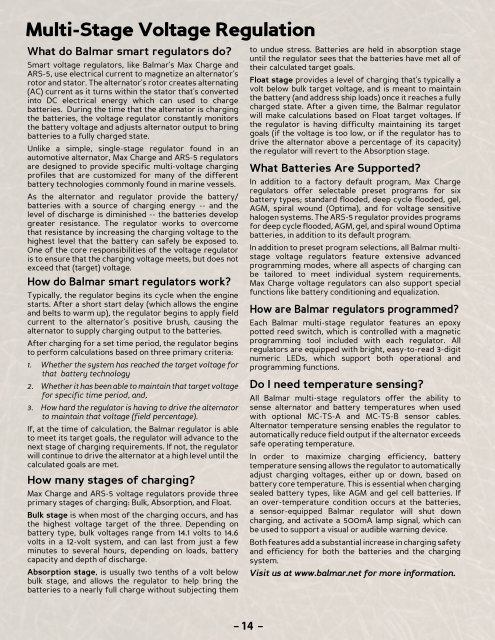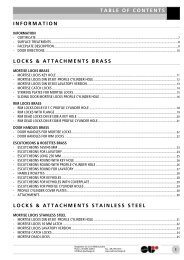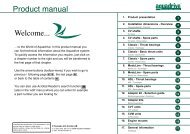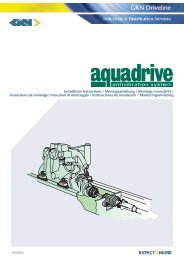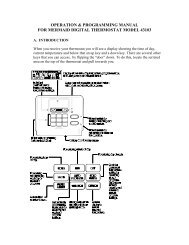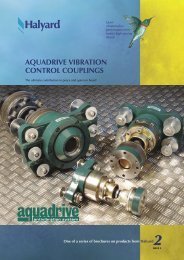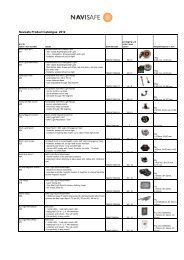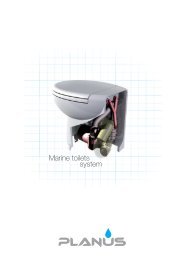PRODUCT CATALOG
PRODUCT CATALOG
PRODUCT CATALOG
You also want an ePaper? Increase the reach of your titles
YUMPU automatically turns print PDFs into web optimized ePapers that Google loves.
Multi-Stage Voltage Regulation<br />
What do Balmar smart regulators do<br />
Smart voltage regulators, like Balmar’s Max Charge and<br />
ARS-5, use electrical current to magnetize an alternator’s<br />
rotor and stator. The alternator’s rotor creates alternating<br />
(AC) current as it turns within the stator that’s converted<br />
into DC electrical energy which can used to charge<br />
batteries. During the time that the alternator is charging<br />
the batteries, the voltage regulator constantly monitors<br />
the battery voltage and adjusts alternator output to bring<br />
batteries to a fully charged state.<br />
Unlike a simple, single-stage regulator found in an<br />
automotive alternator, Max Charge and ARS-5 regulators<br />
are designed to provide specific multi-voltage charging<br />
profiles that are customized for many of the different<br />
battery technologies commonly found in marine vessels.<br />
As the alternator and regulator provide the battery/<br />
batteries with a source of charging energy -- and the<br />
level of discharge is diminished -- the batteries develop<br />
greater resistance. The regulator works to overcome<br />
that resistance by increasing the charging voltage to the<br />
highest level that the battery can safely be exposed to.<br />
One of the core responsibilities of the voltage regulator<br />
is to ensure that the charging voltage meets, but does not<br />
exceed that (target) voltage.<br />
How do Balmar smart regulators work<br />
Typically, the regulator begins its cycle when the engine<br />
starts. After a short start delay (which allows the engine<br />
and belts to warm up), the regulator begins to apply field<br />
current to the alternator’s positive brush, causing the<br />
alternator to supply charging output to the batteries.<br />
After charging for a set time period, the regulator begins<br />
to perform calculations based on three primary criteria:<br />
1. Whether the system has reached the target voltage for<br />
that battery technology<br />
2. Whether it has been able to maintain that target voltage<br />
for specific time period, and,<br />
3. How hard the regulator is having to drive the alternator<br />
to maintain that voltage (field percentage).<br />
If, at the time of calculation, the Balmar regulator is able<br />
to meet its target goals, the regulator will advance to the<br />
next stage of charging requirements. If not, the regulator<br />
will continue to drive the alternator at a high level until the<br />
calculated goals are met.<br />
How many stages of charging<br />
Max Charge and ARS-5 voltage regulators provide three<br />
primary stages of charging: Bulk, Absorption, and Float.<br />
Bulk stage is when most of the charging occurs, and has<br />
the highest voltage target of the three. Depending on<br />
battery type, bulk voltages range from 14.1 volts to 14.6<br />
volts in a 12-volt system, and can last from just a few<br />
minutes to several hours, depending on loads, battery<br />
capacity and depth of discharge.<br />
Absorption stage, is usually two tenths of a volt below<br />
bulk stage, and allows the regulator to help bring the<br />
batteries to a nearly full charge without subjecting them<br />
to undue stress. Batteries are held in absorption stage<br />
until the regulator sees that the batteries have met all of<br />
their calculated target goals.<br />
Float stage provides a level of charging that’s typically a<br />
volt below bulk target voltage, and is meant to maintain<br />
the battery (and address ship loads) once it reaches a fully<br />
charged state. After a given time, the Balmar regulator<br />
will make calculations based on Float target voltages. If<br />
the regulator is having difficulty maintaining its target<br />
goals (if the voltage is too low, or if the regulator has to<br />
drive the alternator above a percentage of its capacity)<br />
the regulator will revert to the Absorption stage.<br />
What Batteries Are Supported<br />
In addition to a factory default program, Max Charge<br />
regulators offer selectable preset programs for six<br />
battery types; standard flooded, deep cycle flooded, gel,<br />
AGM, spiral wound (Optima), and for voltage sensitive<br />
halogen systems. The ARS-5 regulator provides programs<br />
for deep cycle flooded, AGM, gel, and spiral wound Optima<br />
batteries, in addition to its default program.<br />
In addition to preset program selections, all Balmar multistage<br />
voltage regulators feature extensive advanced<br />
programming modes, where all aspects of charging can<br />
be tailored to meet individual system requirements.<br />
Max Charge voltage regulators can also support special<br />
functions like battery conditioning and equalization.<br />
How are Balmar regulators programmed<br />
Each Balmar multi-stage regulator features an epoxy<br />
potted reed switch, which is controlled with a magnetic<br />
programming tool included with each regulator. All<br />
regulators are equipped with bright, easy-to-read 3-digit<br />
numeric LEDs, which support both operational and<br />
programming functions.<br />
Do I need temperature sensing<br />
All Balmar multi-stage regulators offer the ability to<br />
sense alternator and battery temperatures when used<br />
with optional MC-TS-A and MC-TS-B sensor cables.<br />
Alternator temperature sensing enables the regulator to<br />
automatically reduce field output if the alternator exceeds<br />
safe operating temperature.<br />
In order to maximize charging efficiency, battery<br />
temperature sensing allows the regulator to automatically<br />
adjust charging voltages, either up or down, based on<br />
battery core temperature. This is essential when charging<br />
sealed battery types, like AGM and gel cell batteries. If<br />
an over-temperature condition occurs at the batteries,<br />
a sensor-equipped Balmar regulator will shut down<br />
charging, and activate a 500mA lamp signal, which can<br />
be used to support a visual or audible warning device.<br />
Both features add a substantial increase in charging safety<br />
and efficiency for both the batteries and the charging<br />
system.<br />
Visit us at www.balmar.net for more information.<br />
– 14 –


